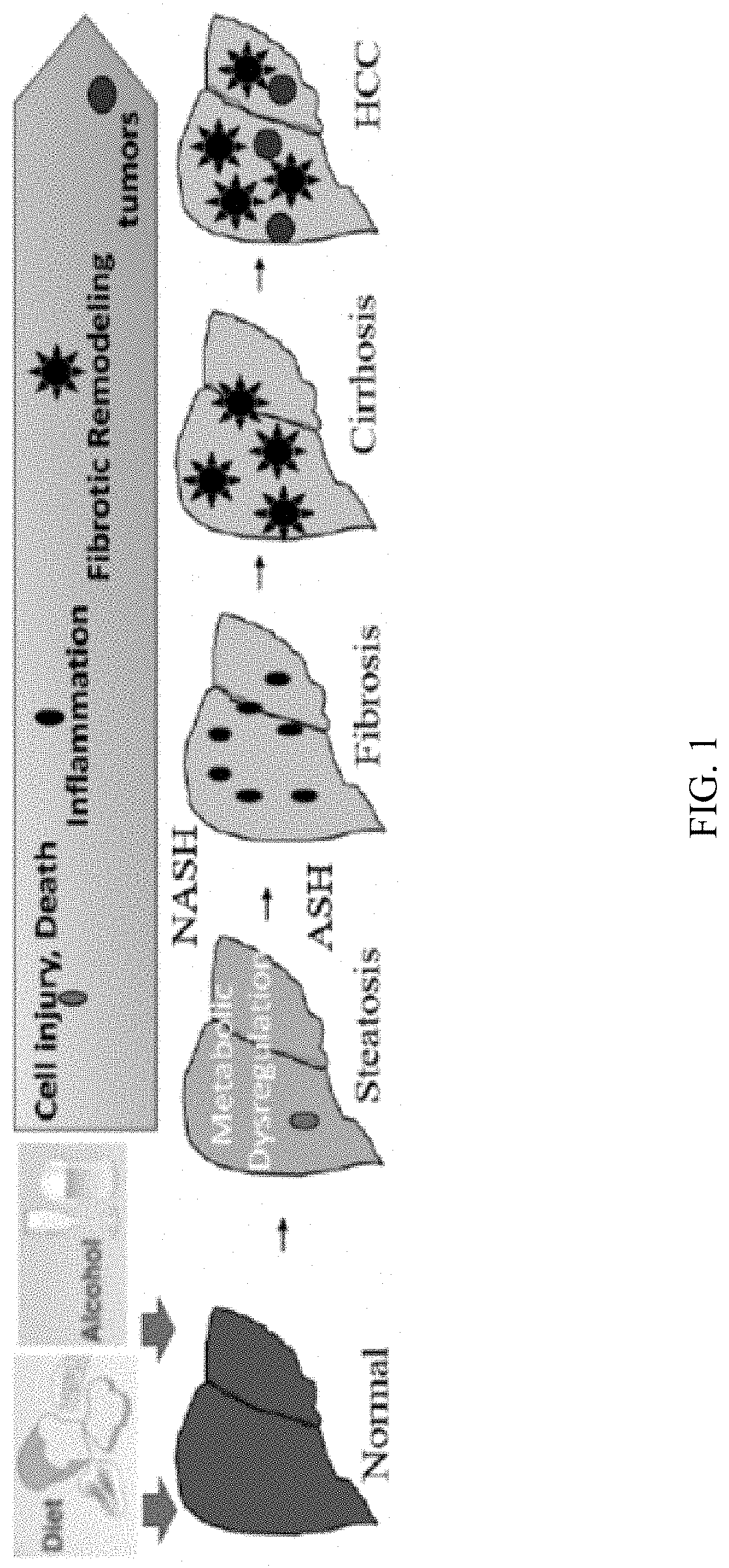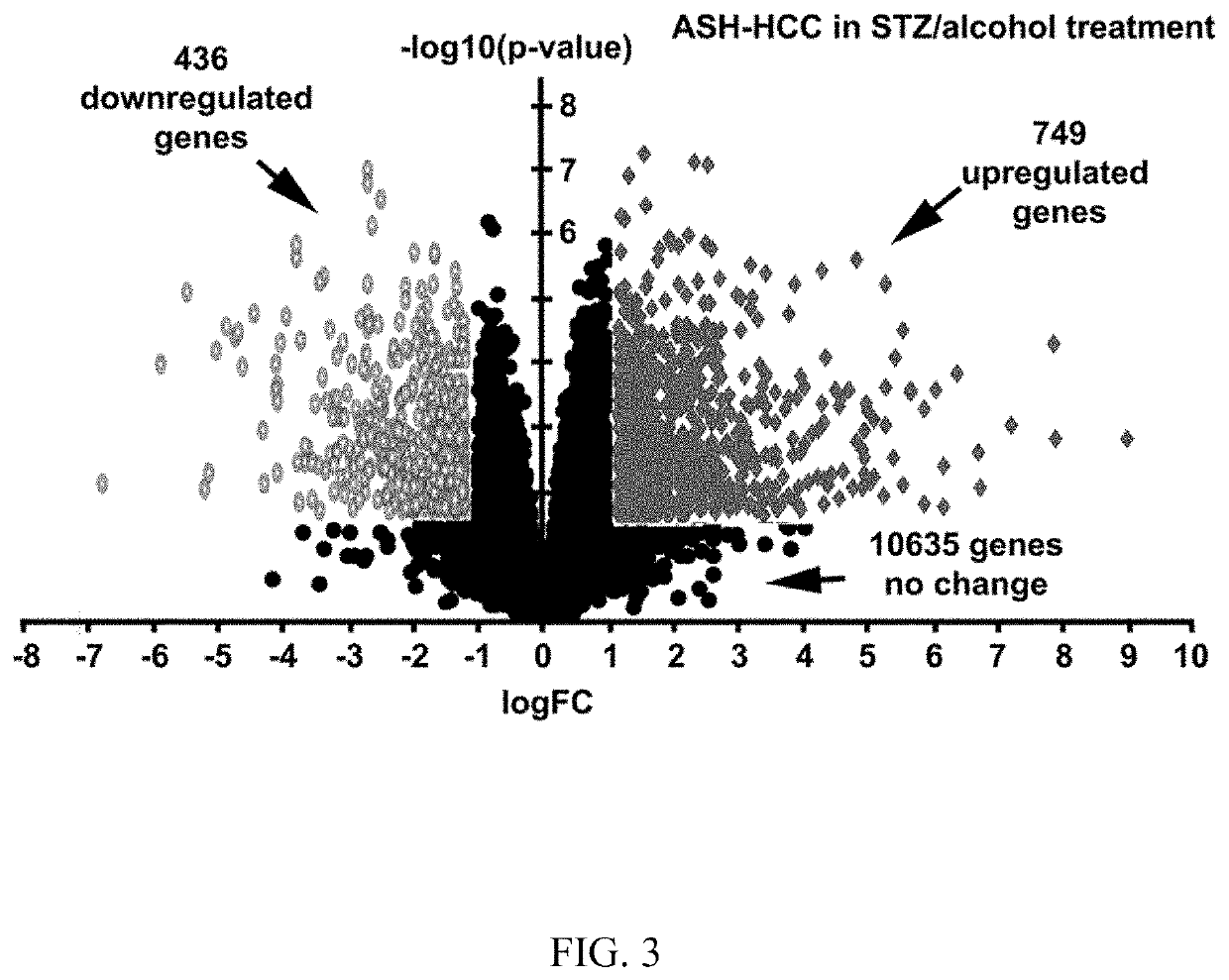Mouse Model of Alcohol-induced Liver Cancer
a mouse model and liver cancer technology, applied in the field of mouse model of alcohol-induced liver cancer, can solve the problems of chronic inflammation leading to cycle damage and renewal, high potential for toxicity from daily food intake, and high blood oxygen concentration in zone 3 , to achieve the effect of preventing liver fibrosis and myofibroblast cell activation
- Summary
- Abstract
- Description
- Claims
- Application Information
AI Technical Summary
Benefits of technology
Problems solved by technology
Method used
Image
Examples
example 1
iated HCC Appear in Diabetic Mice after Streptozotocin Administration and Four-Month-Alcohol Feeding
[0073]Fujii et al. developed NASH-derived HCC model (STAM model) using STZ and HFD32.15 This model replicates clinicopathological processes from fatty liver, NASH, fibrosis to HCC under diabetic background. The very high fat diet (HFD: 60% kcal fat) in combination with STZ also could induced morphologically detectable protrusion of liver tumor nodules at postnatal week 16. We have established a novel model in which ASH-associated liver cancer occurs in STZ-treated mice within 6 months after start of alcohol consumption (FIG. 2, 12). Mice were administered STZ on day two after birth. The STZ was administered in a dose sufficient to kill insulin-producing cells, and lead to diabetic mice. The streptozotocin-treated mice were then fed a Lieber-Decarli alcohol-liquid diet (EtOH) for four months starting at 8 weeks of age. Streptozotocin (200 μg / pup) was given through subcutaneous injectio...
example 2
ncing Reveals Transcriptomic Changes and Upregulation of Similar Sets of Cell Cycle Regulators Between NASH and ASH-Associated HCC in Diabetic Mouse Livers
[0075]To understand the molecular mechanism underlying NASH to HCC and ASH to and ASH development in the setting of a diabetic condition, we isolated RNAs of STZ / HFD or STZ / alcohol-induced tumors. Adjacent non-tumor tissues were isolated for comparison of corresponding tumors. RNA Sequencing (Seq) analysis was performed to compare whole genome transcriptomes between tumors and their control tissues. In total, 11,823 transcripts were analyzed. As shown in FIGS. 3 and 13A, 353 genes were upregulated and 534 genes were downregulated during NASH to HCC progression in the STZ / HFD treatment. In contrast, there were 749 upregulated genes and 436 downregulated genes during ASH to HCC development in the STV / alcohol treatment.
[0076]About twenty-two key regulators in cell cycles were upregulated in both STZ / HFD- and STZ / alcohol-induced tumor...
example 3
ysis Reveals that ASH-Associated HCC by STZ and HFD Belong to Hoshida Subclass S1 Characterized by Activation of TGF / 3 Signaling and Upregulation of P53 Signature, while NASH-Associated HCC Caused by STZ and HFD Belong to Hoshida Subclass S3 with Well-Differentiated Characteristics Whereas
[0077]Three robust HCC subclasses (termed 51, S2, and S3) have been classified in human patients according to Hoshida et al., (Cancer Research 2009). Each subclass is correlated with clinical parameters such as tumor size, extent of cellular differentiation, and serum alpha-fetoprotein levels. S1 reflected aberrant activation of the WNT signaling pathway. S2 was characterized by proliferation as well as MYC and AKT activation. S3 was associated with hepatocyte differentiation. Functional studies indicated that the WNT pathway activation signature characteristic of S1 tumors was not simply the result of β-catenin mutation but rather was the result of transforming growth factor-β activation. Thus, re...
PUM
 Login to View More
Login to View More Abstract
Description
Claims
Application Information
 Login to View More
Login to View More - R&D
- Intellectual Property
- Life Sciences
- Materials
- Tech Scout
- Unparalleled Data Quality
- Higher Quality Content
- 60% Fewer Hallucinations
Browse by: Latest US Patents, China's latest patents, Technical Efficacy Thesaurus, Application Domain, Technology Topic, Popular Technical Reports.
© 2025 PatSnap. All rights reserved.Legal|Privacy policy|Modern Slavery Act Transparency Statement|Sitemap|About US| Contact US: help@patsnap.com



